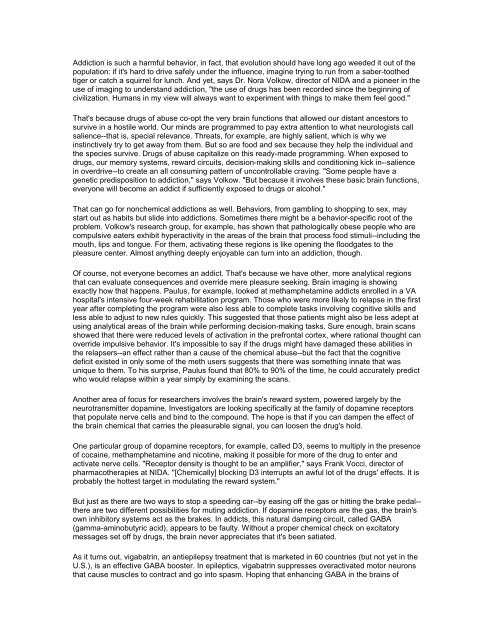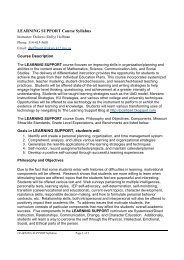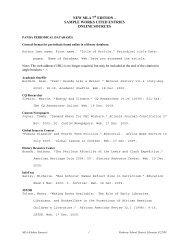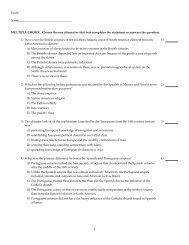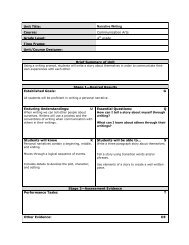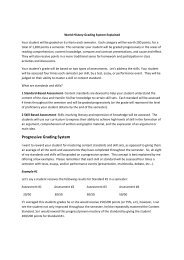The Science Of Addiction
The Science Of Addiction
The Science Of Addiction
You also want an ePaper? Increase the reach of your titles
YUMPU automatically turns print PDFs into web optimized ePapers that Google loves.
<strong>Addiction</strong> is such a harmful behavior, in fact, that evolution should have long ago weeded it out of the<br />
population: if it's hard to drive safely under the influence, imagine trying to run from a saber-toothed<br />
tiger or catch a squirrel for lunch. And yet, says Dr. Nora Volkow, director of NIDA and a pioneer in the<br />
use of imaging to understand addiction, "the use of drugs has been recorded since the beginning of<br />
civilization. Humans in my view will always want to experiment with things to make them feel good."<br />
That's because drugs of abuse co-opt the very brain functions that allowed our distant ancestors to<br />
survive in a hostile world. Our minds are programmed to pay extra attention to what neurologists call<br />
salience--that is, special relevance. Threats, for example, are highly salient, which is why we<br />
instinctively try to get away from them. But so are food and sex because they help the individual and<br />
the species survive. Drugs of abuse capitalize on this ready-made programming. When exposed to<br />
drugs, our memory systems, reward circuits, decision-making skills and conditioning kick in--salience<br />
in overdrive--to create an all consuming pattern of uncontrollable craving. "Some people have a<br />
genetic predisposition to addiction," says Volkow. "But because it involves these basic brain functions,<br />
everyone will become an addict if sufficiently exposed to drugs or alcohol."<br />
That can go for nonchemical addictions as well. Behaviors, from gambling to shopping to sex, may<br />
start out as habits but slide into addictions. Sometimes there might be a behavior-specific root of the<br />
problem. Volkow's research group, for example, has shown that pathologically obese people who are<br />
compulsive eaters exhibit hyperactivity in the areas of the brain that process food stimuli--including the<br />
mouth, lips and tongue. For them, activating these regions is like opening the floodgates to the<br />
pleasure center. Almost anything deeply enjoyable can turn into an addiction, though.<br />
<strong>Of</strong> course, not everyone becomes an addict. That's because we have other, more analytical regions<br />
that can evaluate consequences and override mere pleasure seeking. Brain imaging is showing<br />
exactly how that happens. Paulus, for example, looked at methamphetamine addicts enrolled in a VA<br />
hospital's intensive four-week rehabilitation program. Those who were more likely to relapse in the first<br />
year after completing the program were also less able to complete tasks involving cognitive skills and<br />
less able to adjust to new rules quickly. This suggested that those patients might also be less adept at<br />
using analytical areas of the brain while performing decision-making tasks. Sure enough, brain scans<br />
showed that there were reduced levels of activation in the prefrontal cortex, where rational thought can<br />
override impulsive behavior. It's impossible to say if the drugs might have damaged these abilities in<br />
the relapsers--an effect rather than a cause of the chemical abuse--but the fact that the cognitive<br />
deficit existed in only some of the meth users suggests that there was something innate that was<br />
unique to them. To his surprise, Paulus found that 80% to 90% of the time, he could accurately predict<br />
who would relapse within a year simply by examining the scans.<br />
Another area of focus for researchers involves the brain's reward system, powered largely by the<br />
neurotransmitter dopamine. Investigators are looking specifically at the family of dopamine receptors<br />
that populate nerve cells and bind to the compound. <strong>The</strong> hope is that if you can dampen the effect of<br />
the brain chemical that carries the pleasurable signal, you can loosen the drug's hold.<br />
One particular group of dopamine receptors, for example, called D3, seems to multiply in the presence<br />
of cocaine, methamphetamine and nicotine, making it possible for more of the drug to enter and<br />
activate nerve cells. "Receptor density is thought to be an amplifier," says Frank Vocci, director of<br />
pharmacotherapies at NIDA. "[Chemically] blocking D3 interrupts an awful lot of the drugs' effects. It is<br />
probably the hottest target in modulating the reward system."<br />
But just as there are two ways to stop a speeding car--by easing off the gas or hitting the brake pedal--<br />
there are two different possibilities for muting addiction. If dopamine receptors are the gas, the brain's<br />
own inhibitory systems act as the brakes. In addicts, this natural damping circuit, called GABA<br />
(gamma-aminobutyric acid), appears to be faulty. Without a proper chemical check on excitatory<br />
messages set off by drugs, the brain never appreciates that it's been satiated.<br />
As it turns out, vigabatrin, an antiepilepsy treatment that is marketed in 60 countries (but not yet in the<br />
U.S.), is an effective GABA booster. In epileptics, vigabatrin suppresses overactivated motor neurons<br />
that cause muscles to contract and go into spasm. Hoping that enhancing GABA in the brains of


